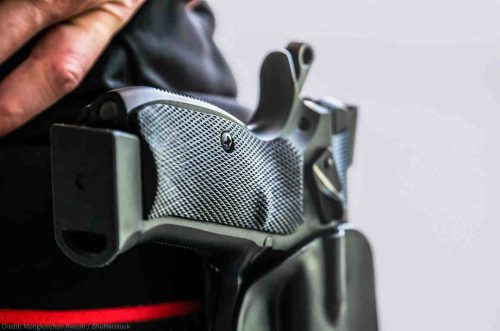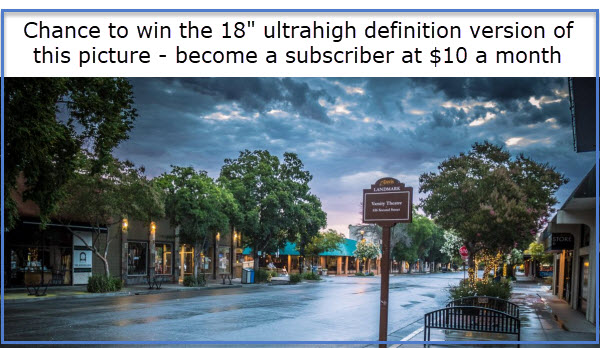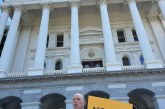 By Carl Takei and Paige Fernandez
By Carl Takei and Paige Fernandez
The most common refrain from gun rights supporters in the wake of mass shootings or other gun violence is that the best response to a bad guy with a gun is a good guy with a gun. Yet in recent weeks, we have seen two Black men, a group already disproportionately victimized by police use of lethal force, shot and killed by police while protecting those around them with guns they were legally allowed to carry.
It turns out that not only are unarmed African-Americans more likely to be shot, but those who seek to follow the advice of the National Rifle Association and others to arm themselves may only make themselves more vulnerable. It is especially troubling that gun rights proponents have largely been silent when police kill Black people for lawfully using their guns.
For example, the NRA and President Trump — despite their embrace of the social media bullhorn — have not condemned the police for killing unarmed Black people. Moreover, they have yet to denounce police officers who kill Black people for possessing guns they’re legally entitled to carry.
The police killings of legally armed Black citizens, and the refusal of leading gun-rights proponents to sincerely defend the victims, raises the same troubling question that both Martin Luther King Jr. and the Black Panther Party also confronted when they tried to exercise their rights to bear arms: In practice, do Second Amendment rights protect only  white gun owners?
white gun owners?
The most recent example is Emantic Fitzgerald Bradford, Jr., a former Army recruit and a licensed firearm owner in Alabama, an open-carry state. The police department has yet to release the video of the incident, but we now know that Bradford was carrying his gun at a mall on Thanksgiving night when someone else began shooting — the kind of situation where gun proponents often claim that being armed will save the day.
Bradford responded by drawing his gun and “directing shoppers to safety,” reported The New York Times. But when the police arrived, witnesses say they shot him “within milliseconds.” The police department initially asserted that Bradford was the mall shooter and lauded his killer as a hero.
But it was wrong.
The department has since admitted this statement was “not totally accurate” in at least two ways. First, the officer shot the wrong man, and the mall shooter was actually still at large. Next, police admitted that Bradford had not “brandished” the gun but simply had it in his hand when officers approached. An independent autopsy has revealed that Bradford was shot three times from behind.
President Trump has had nothing to say about this tragedy. The most to come from the NRA is spokesperson Dana Loesch tweeting her surprise that the police have refused to release the bodycam footage. But even that statement took more than a week. As Black Alabamans and racial justice allies protested in the days following Bradford’s death, the organization said nothing about the reality of race in America or about how Black men are denied the right to bear arms that others enjoy.
Instead of acknowledging Bradford, a real-life good guy with a gun, it tweeted a quote from its executive vice president, Wayne LaPierre: “To preserve our values and protect our freedom, America needs the good guys to step up like never before.”
And Bradford’s death isn’t even an isolated incident.
Just two weeks prior, police officers killed Jemel Roberson, a Black security guard and registered gun owner, who responded when several men began shooting at the Illinois nightclub where he worked. When the police arrived, Roberson was doing his job: He legally had his gun out and had subdued one of the men with his knee in the man’s back.
It didn’t matter.
The officers shot and killed Roberson, even as witnesses warned them he was a security guard. Roberson has widely been lauded as a hero, and even the police department later conceded  Roberson was “a brave man who was doing his best to end an active shooter situation.”
Roberson was “a brave man who was doing his best to end an active shooter situation.”
But again, gun rights proponents have been quiet.
When Philando Castile was killed in 2016 after telling the police officer who stopped his car that he had a gun and a license to carry one — the recommended procedure for announcing the presence of a gun to an officer — gun rights advocates were again silent. The NRA said nothing about Castile’s case for more than a year.
When Loesch finally did offer a statement, she stopped short of criticizing the police officer, cryptically saying that “… there were a lot of things that I wish would have been done differently.” She suggested that an NRA Carry Guard card could have prevented his killing. But the officer shot Mr. Castile while he was reaching for his driver’s license and registration, so it’s not clear how having an NRA card in his wallet could have possibly helped.
This equivocation is unprincipled. Whatever one’s view of the appropriate scope of the Second Amendment, it ought to extend to all equally, without regard to race.
Carl Takei is the Senior Staff Attorney with ACLU’s Trone Center for Justice and Equality & Paige Fernandez is a Policing Policy Advisor with the ACLU






‘‘I Am the ‘Good Guy With a Gun’’’: Black Gun Owners Reject Stereotypes, Demand Respect
I’d like to hear second amendment advocate Maria Butina’s ideas about this topic.
Bit of a “stretch”, John… she used a NRA association as a ‘useful fool’ tool… she’d likely not advocate gun rights in Russia..
But, it ‘shows to go’ that she picked NRA for “cover”…
NRA is interesting, in my view… applaud their offering training for responsible gun owners… second to none, I really respect that!
Yet, they have a dark side… so protective of responsible gun owners, that they fervently resist any laws that would keep ‘weapons of mass destruction’ (aka assault rifles, big clips, etc.) out of the hands of the mentally disturbed, other folk who are ‘not good people’ as far as weapon ownership… aka, irresponsible weapon owners… Sandy Hook comes to mind today…
Maria Butina is a criminal, agent-provocateur, whatever. Not a good person. The NRA thing appears to have been a means to an end for her. No sympathy for her.
“Maria Butina is a criminal, agent-provocateur, whatever. Not a good person. The NRA thing appears to have been a means to an end for her. No sympathy for her.”
But she looks great holding an AR-15.
When the police get a call of a shooting in progress and arrive on the scene they generally do not stop and interview everyone who has a firearm in their hands to inquire if they might happen to be the good guys or the bad guys. They assume that the 1st and every person they see with a gun in their hands are the bad guys, and usually shoot first and ask questions later.
During the Oregon Umpqua Community College mass shooting in 2015 where 9 were killed and another 8 wounded a student on campus during the shooting was was a former Army Ranger who stated he had a gun in his bookbag at the time and he believed there were several other students who also had guns with them. He stated he did not try to use his gun to stop the shooter or even pull his gun out because he knew 911 had already been called, the police were on their way, and when the police arrived they were going to assume whoever they saw with a gun was the shooter(s) and immediately shoot them.
Roland G. Fryer, the Harvard economist who looked at police use of force including shootings found: “On non-lethal uses of force, blacks and Hispanics are more than fifty percent more likely to experience some form of force in interactions with police. Adding controls that account for important context and civilian behavior reduces, but cannot fully explain, these disparities. On the most extreme use of force – officer-involved shootings – we find no racial differences in either the raw data or when contextual factors are taken into account.” So if you are Hispanic or Black it appears you are 50% more likely to be cuffed, thrown to the ground, slammed against the car, tasered, pepper sprayed, beat with a baton, punched, or otherwise be on the receiving end of some pretty serious use of non-lethal force. You are however no more likely to be shot by the police than a white subject.
With respect to Philando Castile I think he was murdered and I see no way that that you could reasonably assume this was a justified shooting.
Yes they can and do… if all the right things are accounted for… but they are not.